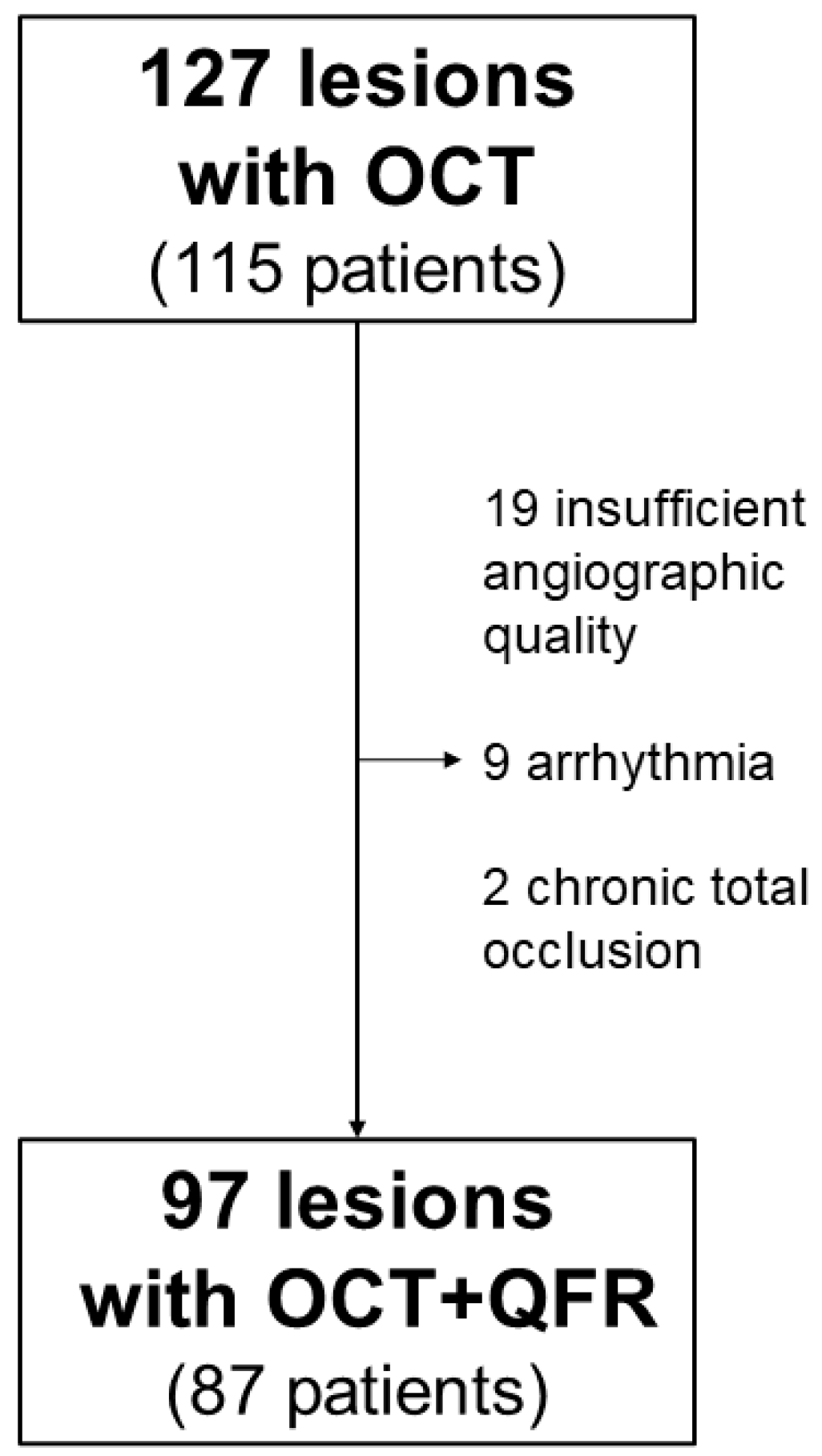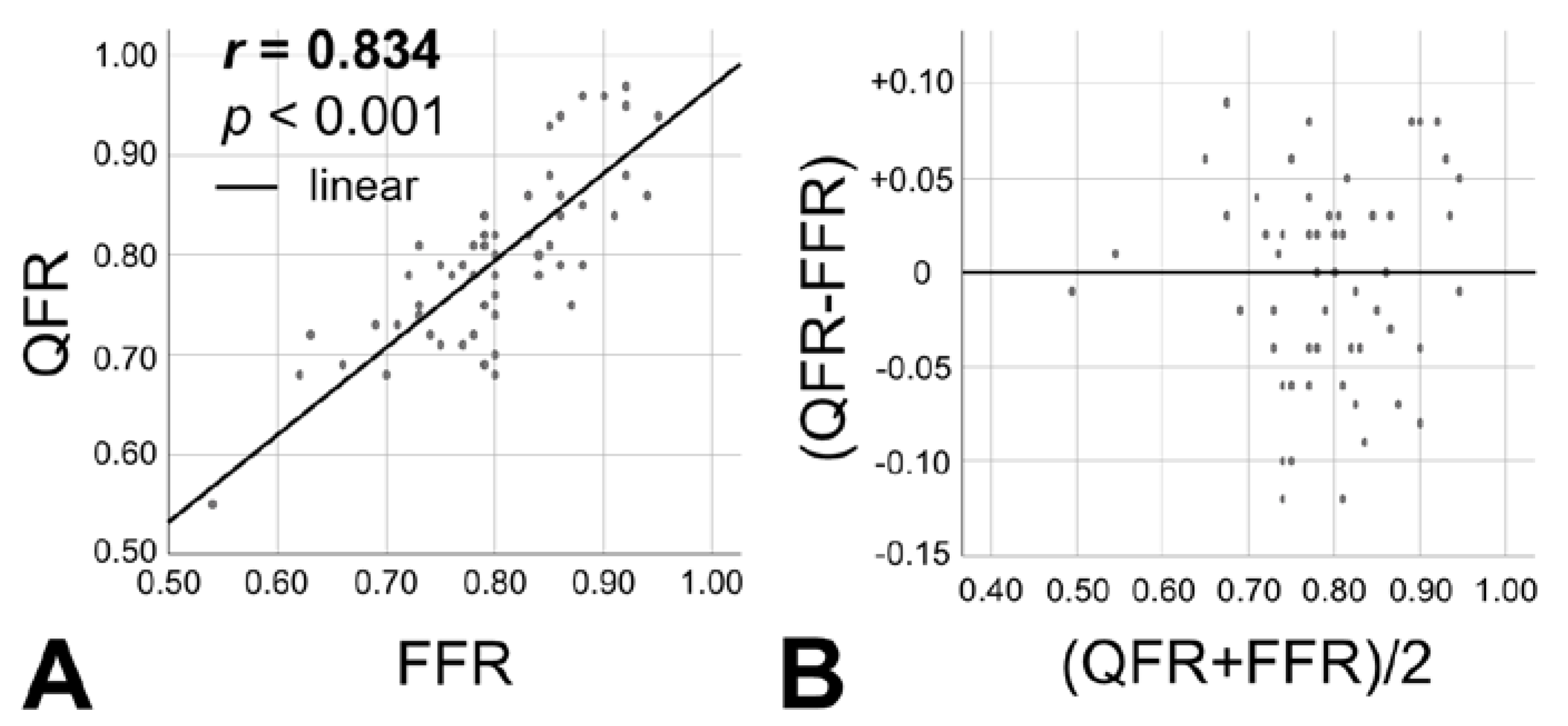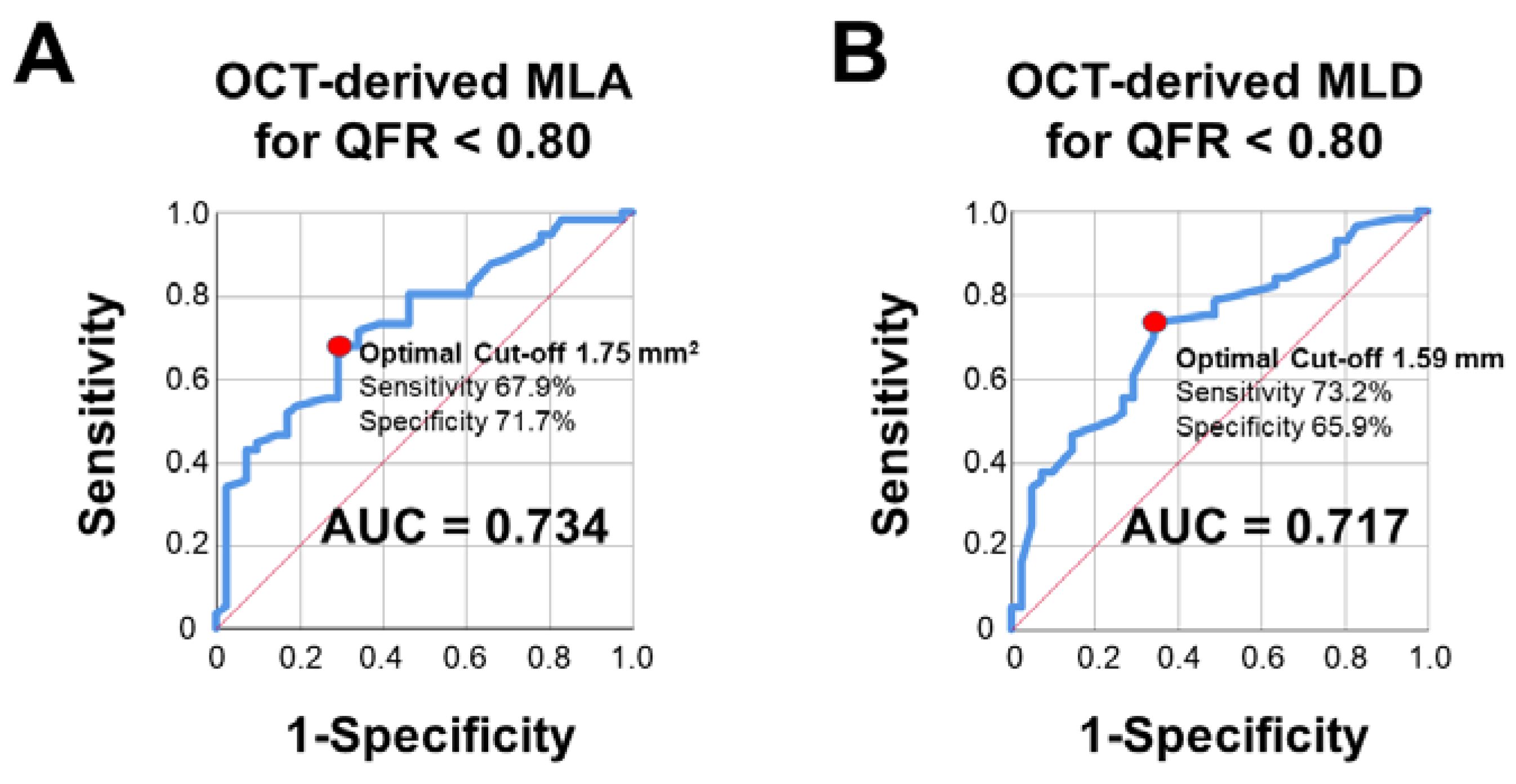Quantitative Flow Ratio Is Related to Intraluminal Coronary Stenosis Parameters as Assessed with Optical Coherence Tomography
Abstract
1. Background
2. Materials and Methods
2.1. Patient Selection
2.2. QFR-Analysis
2.3. OCT-Image Acquisition and Analysis
2.4. Statistical Analysis
3. Results
3.1. Patient and Lesion Characteristics
3.2. Association between FFR and QFR
3.3. Association between OCT and Quantitative Angiography-Derived Stenosis Parameters
3.4. Association between OCT-Derived Stenosis Parameters and QFR
3.5. Association between Plaque Vulnerability and QFR
4. Discussion
- Stenosis parameters measured by OCT are significantly associated with QFR.
- Furthermore, stenosis parameters in OCT are consistent with assessment of lesion morphology by 3D-quantitative coronary angiography.
- An OCT-derived MLA of 1.75 mm2 and an MLD of 1.59 mm were the optimal cut-offs for predicting hemodynamic relevance of coronary lesions according to QFR.
- Plaque vulnerability is not associated to QFR.
4.1. QFR Is Associated with OCT-Derived Intraluminal Stenosis Parameter
4.2. QFR Is not Associated with Plaque Vulnerability
5. Limitations
6. Conclusions
Author Contributions
Funding
Institutional Review Board Statement
Informed Consent Statement
Data Availability Statement
Conflicts of Interest
References
- Neumann, F.-J.; Sousa-Uva, M.; Ahlsson, A.; Alfonso, F.; Banning, A.P.; Benedetto, U.; A Byrne, R.; Collet, J.-P.; Falk, V.; Head, S.J.; et al. 2018 ESC/EACTS Guidelines on myocardial revascularization. The Task Force on myocardial revascularization of the European Society of Cardiology (ESC) and European Association for Cardio-Thoracic Surgery (EACTS). Eur. Heart J. 2019, 40, 87–165. [Google Scholar] [CrossRef]
- Saraste, A.; Knuuti, J. ESC 2019 guidelines for the diagnosis and management of chronic coronary syndromes: Recommendations for cardiovascular imaging. Herz 2020, 45, 409–420. [Google Scholar] [CrossRef]
- Schampaert, E.; Kumar, G.; Achenbach, S.; Galli, S.; Tanaka, N.; Teraphongphom, T.; Ginn, G.; Zhang, Z.; Somi, S.; Amoroso, G.; et al. A global registry of fractional flow reserve (FFR)–guided management during routine care: Study design, baseline characteristics and outcomes of invasive management. Catheter. Cardiovasc. Interv. 2020, 96, E423–E431. [Google Scholar] [CrossRef]
- Curzen, N.; Rana, O.; Nicholas, Z.; Golledge, P.; Zaman, A.; Oldroyd, K.; Hanratty, C.; Banning, A.; Wheatcroft, S.; Hobson, A.; et al. Does routine pressure wire assessment influence management strategy at coronary angiography for diagnosis of chest pain? The RIPCORD study. Circ. Cardiovasc. Interv. 2014, 7, 248–255. [Google Scholar] [CrossRef]
- Tu, S.; Westra, J.; Yang, J.; von Birgelen, C.; Ferrara, A.; Pellicano, M.; Nef, H.; Tebaldi, M.; Murasato, Y.; Lansky, A.; et al. Diagnostic Accuracy of Fast Computational Approaches to Derive Fractional Flow Reserve from Diagnostic Coronary Angiography: The International Multicenter FAVOR Pilot Study. JACC Cardiovasc. Interv. 2016, 9, 2024–2035. [Google Scholar] [CrossRef]
- Westra, J.; Andersen, B.K.; Campo, G.; Matsuo, H.; Koltowski, L.; Eftekhari, A.; Liu, T.; Di Serafino, L.; Di Girolamo, D.; Escaned, J.; et al. Diagnostic Performance of In-Procedure Angiography-Derived Quantitative Flow Reserve Compared to Pressure-Derived Fractional Flow Reserve: The FAVOR II Europe-Japan Study. J. Am. Heart Assoc. 2018, 7. [Google Scholar] [CrossRef] [PubMed]
- Westra, J.; Tu, S.; Winther, S.; Nissen, L.; Vestergaard, M.; Andersen, B.K.; Holck, E.N.; Maule, C.F.; Johansen, J.K.; Andreasen, L.N.; et al. Evaluation of Coronary Artery Stenosis by Quantitative Flow Ratio During Invasive Coronary Angiography: The WIFI II Study (Wire-Free Functional Imaging II). Circ. Cardiovasc. Imaging 2018, 11, e007107. [Google Scholar] [CrossRef]
- Xu, B.; Tu, S.; Qiao, S.; Qu, X.; Chen, Y.; Yang, J.; Guo, L.; Sun, Z.; Li, Z.; Tian, F.; et al. Diagnostic Accuracy of Angiography-Based Quantitative Flow Ratio Measurements for Online Assessment of Coronary Stenosis. J. Am. Coll. Cardiol. 2017, 70, 3077–3087. [Google Scholar] [CrossRef] [PubMed]
- Hwang, D.; Choi, K.H.; Lee, J.M.; Mejía-Rentería, H.; Kim, J.; Park, J.; Rhee, T.; Jeon, K.; Lee, H.; Kim, H.K.; et al. Diagnostic Agreement of Quantitative Flow Ratio With Fractional Flow Reserve and Instantaneous Wave-Free Ratio. J. Am. Heart Assoc. 2019, 8, e011605. [Google Scholar] [CrossRef] [PubMed]
- Johnson, T.W.; Räber, L.; Di Mario, C.; Bourantas, C.; Jia, H.; Mattesini, A.; Gonzalo, N.; Hernandez, J.M.D.L.T.; Prati, F.; Koskinas, K.; et al. Clinical use of intracoronary imaging. Part 2: Acute coronary syndromes, ambiguous coronary angiography findings, and guiding interventional decision-making: An expert consensus document of the European Association of Percutaneous Cardiovascular Interventions. Eur. Heart J. 2019, 40, 2566–2584. [Google Scholar] [CrossRef] [PubMed]
- Räber, L.; Mintz, G.S.; Koskinas, K.C.; Johnson, T.W.; Holm, N.R.; Onuma, Y.; Radu, M.D.; Joner, M.; Yu, B.; Jia, H.; et al. Clinical use of intracoronary imaging. Part 1: Guidance and optimization of coronary interventions. An expert consensus document of the European Association of Percutaneous Cardiovascular Interventions. Eur. Heart J. 2018, 39, 3281–3300. [Google Scholar] [CrossRef]
- Burgmaier, M.; Milzi, A.; Dettori, R.; Burgmaier, K.; Hellmich, M.; Almalla, M.; Marx, N.; Reith, S. Colocalization of plaque macrophages and calcification in coronary plaques as detected by optical coherence tomography predicts cardiovascular outcome. Cardiol. J. 2020, 27, 303–306. [Google Scholar] [CrossRef] [PubMed]
- Burgmaier, M.; Milzi, A.; Dettori, R.; Burgmaier, K.; Marx, N.; Reith, S. Co-localization of plaque macrophages with calcification is associated with a more vulnerable plaque phenotype and a greater calcification burden in coronary target segments as determined by OCT. PLoS ONE 2018, 13, e0205984. [Google Scholar] [CrossRef] [PubMed]
- Dettori, R.; Milzi, A.; Burgmaier, K.; Almalla, M.; Hellmich, M.; Marx, N.; Reith, S.; Burgmaier, M. Prognostic irrelevance of plaque vulnerability following plaque sealing in high-risk patients with type 2 diabetes: An optical coherence tomography study. Cardiovasc. Diabetol. 2020, 19, 1–11. [Google Scholar] [CrossRef]
- Milzi, A.; Burgmaier, M.; Burgmaier, K.; Hellmich, M.; Marx, N.; Reith, S. Type 2 diabetes mellitus is associated with a lower fibrous cap thickness but has no impact on calcification morphology: An intracoronary optical coherence tomography study. Cardiovasc. Diabetol. 2017, 16, 1–9. [Google Scholar] [CrossRef] [PubMed]
- Reith, S.B.; Battermann, S.; Jaskolka, A.; Lehmacher, W.; Hoffmann, R.; Marx, N.; Burgmaier, M. Relationship between optical coherence tomography derived intraluminal and intramural criteria and haemodynamic relevance as determined by fractional flow reserve in intermediate coronary stenoses of patients with type 2 diabetes. Heart 2013, 99, 700–707. [Google Scholar] [CrossRef] [PubMed]
- Reith, S.; Milzi, A.; Dettori, R.; Marx, N.; Burgmaier, M. Predictors for target lesion microcalcifications in patients with stable coronary artery disease: An optical coherence tomography study. Clin. Res. Cardiol. 2018, 107, 763–771. [Google Scholar] [CrossRef]
- Reith, S.; Milzi, A.; Lemma, E.D.; Dettori, R.; Burgmaier, K.; Marx, N.; Burgmaier, M. Intrinsic calcification angle: A novel feature of the vulnerable coronary plaque in patients with type 2 diabetes: An optical coherence tomography study. Cardiovasc. Diabetol. 2019, 18, 1–12. [Google Scholar] [CrossRef]
- Tearney, G.J.; Regar, E.; Akasaka, T. Consensus standards for acquisition, measurement, and reporting of intravascular optical coherence tomography studies: A report from the International Working Group for Intravascular Optical Coherence Tomography Standardization and Validation. J. Am. Coll. Cardiol. 2012, 59, 1058–1072. [Google Scholar] [CrossRef]
- Šimundić, A.-M. Measures of Diagnostic Accuracy: Basic Definitions. EJIFCC 2009, 19, 203–211. [Google Scholar]
- Gonzalo, N.; Escaned, J.; Alfonso, F.; Nolte, C.; Rodriguez, V.; Jimenez-Quevedo, P.; Bañuelos, C.; Fernández-Ortiz, A.; Garcia, E.; Hernandez-Antolin, R.; et al. Morphometric assessment of coronary stenosis relevance with optical coherence tomography: A comparison with fractional flow reserve and intravascular ultrasound. J. Am. Coll. Cardiol. 2012, 59, 1080–1089. [Google Scholar] [CrossRef] [PubMed]
- Pawlowski, T.; Prati, F.; Kulawik, T.; Ficarra, E.; Bil, J.; Gil, R. Optical coherence tomography criteria for defining functional severity of intermediate lesions: A comparative study with FFR. Int. J. Cardiovasc. Imaging 2013, 29, 1685–1691. [Google Scholar] [CrossRef] [PubMed]
- Pyxaras, S.A.; Tu, S.; Barbato, E.; Barbati, G.; Di Serafino, L.; De Vroey, F.; Toth, G.; Mangiacapra, F.; Sinagra, G.; De Bruyne, B.; et al. Quantitative angiography and optical coherence tomography for the functional assessment of nonobstructive coronary stenoses: Comparison with fractional flow reserve. Am. Heart J. 2013, 166, 1010–1018.e1. [Google Scholar] [CrossRef] [PubMed]
- Shiono, Y.; Kitabata, H.; Kubo, T.; Masuno, T.; Ohta, S.; Ozaki, Y.; Sougawa, H.; Orii, M.; Shimamura, K.; Ishibashi, K.; et al. Optical Coherence Tomography-Derived Anatomical Criteria for Functionally Significant Coronary Stenosis Assessed by Fractional Flow Reserve. Circ. J. 2012, 76, 2218–2225. [Google Scholar] [CrossRef] [PubMed]
- Kanno, Y.; Sugiyama, T.; Hoshino, M.; Usui, E.; Hamaya, R.; Kanaji, Y.; Murai, T.; Lee, T.; Yonetsu, T.; Kakuta, T. Optical coherence tomography-defined plaque vulnerability in relation to functional stenosis severity stratified by fractional flow reserve and quantitative flow ratio. Catheter. Cardiovasc. Interv. 2020, 96, E238–E247. [Google Scholar] [CrossRef] [PubMed]
- Safi, H.; Bourantas, C.V.; Ramasamy, A.; Zanchin, T.; Bär, S.; Tufaro, V.; Jin, C.; Torii, R.; Karagiannis, A.; Reiber, J.H.C.; et al. Predictive value of the QFR in detecting vulnerable plaques in non-flow limiting lesions: A combined analysis of the PROSPECT and IBIS-4 study. Int. J. Cardiovasc. Imaging 2020, 36, 993–1002. [Google Scholar] [CrossRef] [PubMed]
- Tebaldi, M.; Biscaglia, S.; Di Girolamo, D.; Erriquez, A.; Penzo, C.; Tumscitz, C.; Campo, G. Angio-Based Index of Microcirculatory Resistance for the Assessment of the Coronary Resistance: A Proof of Concept Study. J. Interv. Cardiol. 2020, 2020, 1–4. [Google Scholar] [CrossRef]
- Prati, F.; Romagnoli, E.; Gatto, L.; La Manna, A.; Burzotta, F.; Ozaki, Y.; Marco, V.; Boi, A.; Fineschi, M.; Fabbiocchi, F.; et al. Relationship between coronary plaque morphology of the left anterior descending artery and 12 months clinical outcome: The CLIMA study. Eur. Heart J. 2019, 41, 383–391. [Google Scholar] [CrossRef]
- Maron, D.J.; Hochman, J.S.; Reynolds, H.R.; Bangalore, S.; O’Brien, S.M.; Boden, W.E.; Chaitman, B.R.; Senior, R.; López-Sendón, J.; Alexander, K.P.; et al. Initial Invasive or Conservative Strategy for Stable Coronary Disease. N. Engl. J. Med. 2020, 382, 1395–1407. [Google Scholar] [CrossRef] [PubMed]






| n = 87 | |
|---|---|
| Age (yrs) | 65.4 ± 11.6 |
| Male sex (n, %) | 62 (71.3) |
| LVEF (%) | 52.9 ± 9.2 |
| CV risk profile | |
| Diabetes (n,%) | 28 (32.2) |
| HbA1c (%) | 6.2 ± 1.4 |
| BMI (kg/m2) | 29.8 ± 5.3 |
| Hypertension (n,%) | 66 (75.9) |
| Family history of CAD (n,%) | 33 (37.9) |
| Nicotin use (n,%) | 24 (27.6) |
| Packyears (PY) | 18.5 ± 28.4 |
| Hyperlipidemia (n, %) | 56 (64.4) |
| Cholesterol (mg/dL) | 187 ± 53 |
| LDLc (mg/dL) | 118 ± 42 |
| HDLc (mg/dL) | 47 ± 14 |
| Triglycerides (mg/dL) | 147 ± 103 |
| CRP (mg/L) | 7 ± 8 |
| Medication | |
| Aspirin (n,%) | 77 (88) |
| Statin (n,%) | 73 (84) |
| Beta Blocker (n,%) | 63 (72) |
| ACEi or ARB (n,%) | 65 (75) |
| n = 97 | |
|---|---|
| Native vessel disease (n,%) | 80 (82.5) |
| In-Stent Restenosis (n,%) | 17 (17.5) |
| Vessel | |
| LAD (n,%) | 59 (60.8) |
| LCx (n,%) | 13 (13.4) |
| RCA (n,%) | 18 (18.6) |
| Diagonal Branch (n,%) | 1 (1) |
| Obtuse branch (n,%) | 5 (5.2) |
| RIM (n,%) | 1 (1) |
| QCA/QFR based characteristics | |
| QFR | 0.79 ± 0.10 |
| QFR ≤ 0.80 | 56 (57.7) |
| MLD in QCA (mm) | 1.3 ± 0.3 |
| %DS in QCA (%) | 48.6 ± 11.2 |
| OCT based characteristics | |
| Proximal RD (mm) | 3.0 ± 0.5 |
| Proximal Reference Area (mm2) | 7.1 ± 2.5 |
| Distal RD (mm) | 2.7 ± 0.6 |
| Distal Reference Area (mm2) | 5.9 ± 2.8 |
| MLD in OCT (mm) | 1.3 ± 0.3 |
| MLA in OCT (mm2) | 1.9 ± 0.9 |
| Stenosis eccentricity (%) | 25.1 ± 11.9 |
| %DS in OCT (%) | 45.3 ± 11.4 |
| %AS in OCT (%) | 69.5 ± 12.5 |
| Mean FCT (µm) | 135 ± 34 |
| Minimal FCT (µm) | 89 ± 33 |
| Macrophage infiltration (n,%) | 40 (41.2%) |
Publisher’s Note: MDPI stays neutral with regard to jurisdictional claims in published maps and institutional affiliations. |
© 2021 by the authors. Licensee MDPI, Basel, Switzerland. This article is an open access article distributed under the terms and conditions of the Creative Commons Attribution (CC BY) license (https://creativecommons.org/licenses/by/4.0/).
Share and Cite
Milzi, A.; Dettori, R.; Burgmaier, K.; Marx, N.; Reith, S.; Burgmaier, M. Quantitative Flow Ratio Is Related to Intraluminal Coronary Stenosis Parameters as Assessed with Optical Coherence Tomography. J. Clin. Med. 2021, 10, 1856. https://doi.org/10.3390/jcm10091856
Milzi A, Dettori R, Burgmaier K, Marx N, Reith S, Burgmaier M. Quantitative Flow Ratio Is Related to Intraluminal Coronary Stenosis Parameters as Assessed with Optical Coherence Tomography. Journal of Clinical Medicine. 2021; 10(9):1856. https://doi.org/10.3390/jcm10091856
Chicago/Turabian StyleMilzi, Andrea, Rosalia Dettori, Kathrin Burgmaier, Nikolaus Marx, Sebastian Reith, and Mathias Burgmaier. 2021. "Quantitative Flow Ratio Is Related to Intraluminal Coronary Stenosis Parameters as Assessed with Optical Coherence Tomography" Journal of Clinical Medicine 10, no. 9: 1856. https://doi.org/10.3390/jcm10091856
APA StyleMilzi, A., Dettori, R., Burgmaier, K., Marx, N., Reith, S., & Burgmaier, M. (2021). Quantitative Flow Ratio Is Related to Intraluminal Coronary Stenosis Parameters as Assessed with Optical Coherence Tomography. Journal of Clinical Medicine, 10(9), 1856. https://doi.org/10.3390/jcm10091856





